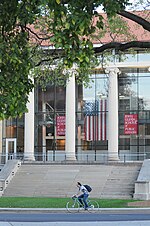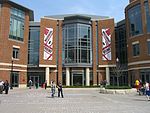Billy Ireland Cartoon Library & Museum

The Billy Ireland Cartoon Library & Museum is a research library of American cartoons and comic art affiliated with the Ohio State University library system in Columbus, Ohio. Formerly known as the Cartoon Research Library and the Cartoon Library & Museum, it holds the world's largest and most comprehensive academic research facility documenting and displaying original and printed comic strips, editorial cartoons, and cartoon art. The museum is named after the Ohio cartoonist Billy Ireland.Covering comic books, daily strips, Sunday strips, editorial cartoons, graphic novels, magazine cartoons, and sports cartoons, the collection includes 450,000 original cartoons, 36,000 books, 51,000 serial titles, and 3,000 feet (910 m) of manuscript materials, plus 2.5 million comic strip clippings and tear sheets.
Excerpt from the Wikipedia article Billy Ireland Cartoon Library & Museum (License: CC BY-SA 3.0, Authors, Images).Billy Ireland Cartoon Library & Museum
North High Street, Columbus
Geographical coordinates (GPS) Address Nearby Places Show on map
Geographical coordinates (GPS)
| Latitude | Longitude |
|---|---|
| N 39.9995 ° | E -83.0088 ° |
Address
Sullivant Hall
North High Street 1813
43210 Columbus
Ohio, United States
Open on Google Maps







